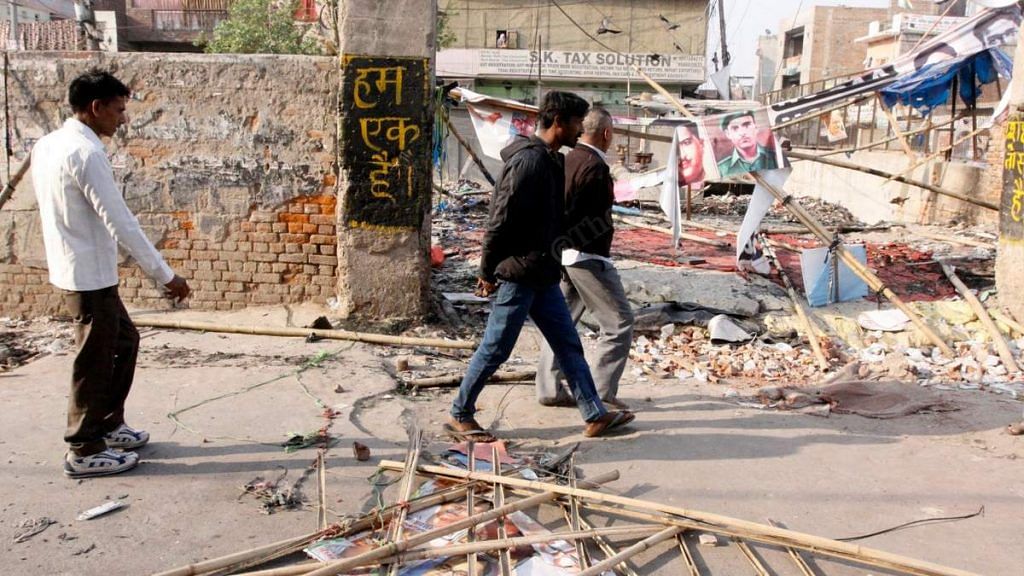Who are the perpetrators of violence in northeast Delhi? Chief Minister Arvind Kejriwal blaming ‘outsiders’—strangers — for the riots may well be a good-intentioned signal for communal solidarity. But it is a recurrent trope in ethnic riots in India, nonetheless. Why then do politicians and, often, even victims of violence blame outsiders for attacks?
There is substantial legal and academic evidence the world over that attackers in mass violence — riots, genocides, and pogroms — are rarely outsiders. Many reside at a median distance of two kilometres from the targeted location of attack. Many are known to the victims.
Examples include the riots in London in 1931 and 2011 and in Uganda in 2003; the genocide of Jews in the Second World War and of Tutsis in Rwanda in 1994; the anti-Tamil pogroms in Sri Lanka, and of Muslims in Gujarat in 2002 and Sikhs in Delhi in 1984. Legal documents for the Naroda Patiya massacre of 97 Muslims in Ahmedabad in 2002 are precise: convicts were ‘born, brought up or have their business places in the area of Naroda Patiya’ and lived or worked ‘at the distance of 200 meters to 400 meters from the S.T. Workshop wall (adjacent to the site of the murders)’.
Also read: Delhi riots neither designed by Modi govt, nor Islamic conspiracy. It’s far more dangerous
‘It wasn’t one of us’
The participation of insiders in violent attacks makes cognitive sense. Where crowds can be mobilised in thousands — many, indeed, formed of strangers — those who lead the crowds and those who actually commit the violence, are a select few. These frontrunners are expert navigators of the localities they target because they know exactly where to attack and how to escape should they be cornered. They may well be motivated by incapacitating emotions of fear and hate, but people who actually do the violence almost never lose sight of their own safety. In his prolific studies of ethnic riots and pogroms, Donald Horowitz has noted that ‘rioters rarely miscalculate their own tactics and power, the intentions of the police, or the response of the targets, such that they suffered more casualties than the targets did’. What appears to be—and is claimed to be—an attack by a faceless, bestial mob has striking aspects of cognition.
Of course, there would be instances when insiders are not involved in attacks. But the rehearsed claim of political leaders in India that ‘it wasn’t one of us’ is trite, untrue and not without reason.
Violence should be projected as what it really is – strategic action by individuals who are sound of mind rather than spontaneous, mindless clashes between frenzied, random people. Political leaders would then be stripped of the excuse of spontaneity and faceless mobs. The excuse is important because – what can the state do but stand and watch helplessly when faced with an enraged ‘mob’ of outsiders? Whom does it prosecute? In places where the state is partly or wholly complicit in mass violence, judicial redress is absent of or delayed for decades.
Also read: Anger towards ‘other side’ echoes in Hindu-dominated areas of riot-hit Northeast Delhi
Neighbours before, neighbours after
Omnibus FIRs — where perpetrators are identified as monolithic ‘mobs’ rather than individuals — were plentiful in Gujarat in 2002. The first convictions in the anti-Sikh 1984 pogrom in Delhi came about three decades later. Judicial redress is essential because it gives a sense of closure to victims of extreme atrocities, else the ‘myth of innocence’ goes on, as it did in West Germany for a decade following the Holocaust until it was disrupted by a series of public trials. Successive Cambodian governments, too, intentionally displayed collective amnesia with regard to the policies of the genocidal Khmer Rouge.
But there is an everyday logic to the outsider alibi. Where the state champions violence against its own citizens, even the tiny proportion of perpetrators who do end up in prison, are let off on parole. Many return to living alongside the victims of their attacks. Not everyone can relocate for want of money. In my study of the anti-Muslim pogrom in Gujarat in 2002, I found that blaming the outsider was a coping mechanism for many victims in the knowledge that living together or in close proximity is inevitable.
Altaf (name changed), one of my Muslim respondents, continued to reside in Naroda Patiya, for want of money to relocate. His neighbour was Parshuram, a Hindu man convicted of the murders. The conviction had come 10 years after the killings. Parshuram had spent a few months in prison but was bailed out on grounds of ill-health. He had returned to his old home. Their recognition of each other was based on the memories of the events of the killings, and the fact that they ‘used to cross paths every other day’. None shared anything more than a polite nod to mutually signal their acquaintance as neighbours. Until the conviction came about, Altaf had not disclosed the name of his neighbour. Since the 32 convicted in 2012 in Naroda Patiya, 11 have been acquitted, others bailed out.
The compulsions of survival have compelled a superficial cordiality between the victims and perpetrators of attacks. The hallmark of a fully functional democracy is the presence of conflict—an environment that invites disagreement and disparages violence. But peace that is based on fear and apprehension of imminent violence has worrying ramifications.
Raheel Dhattiwala is a sociologist trained at Oxford. She is the author of Keeping the Peace: Spatial Differences in Hindu-Muslim Violence in Gujarat in 2002 published by Cambridge University Press.
Views are personal.
